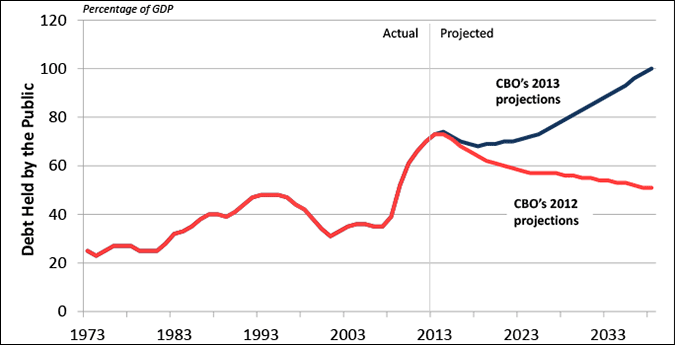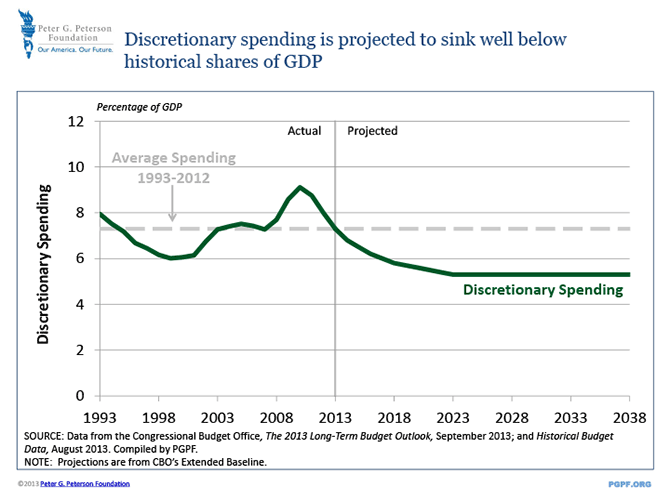You are here
CBO 2013 Long-Term Budget Outlook Analysis
Highlights and Key Takeaways
The Congressional Budget Office’s new long-term projections show that the federal budget is on an unsustainable path. Within 25 years, under laws currently in place:
- Federal debt is projected to reach 100% of GDP and, under an alternate scenario, could rise to 190% of GDP
- Interest on the debt will rise from 1.3% of GDP this year to nearly 5% of GDP
- Spending on Social Security, Medicare, Medicaid and insurance exchange subsidies will account for all of the growth in noninterest spending
- Major entitlement programs are predicted to grow to 14% of GDP — double their historical average of 7% — due largely to an aging population and growing health care costs
- Revenue is projected to increase from 17% of GDP in 2013 to 19.7% of GDP
U.S. debt is on an unsustainable path if current laws remain unchanged

SOURCE: Data from the Congressional Budget Office, The 2013 Long-Term Budget Outlook, September 2013. Compiled by PGPF.
NOTE: Projections are from CBO's Extended Baseline.
In its 2013 Long-Term Budget Outlook, the Congressional Budget Office (CBO) issued a warning that the national debt is near an all-time high and will grow to unsustainable levels. Currently, the federal debt is about 73 percent of GDP. CBO projects that debt will climb to 100 percent of GDP within 25 years. This assumes, however, that current law will not be changed and discretionary spending will decline to historically low levels. Under more pessimistic assumptions, debt could grow to 190 percent of GDP by 2038.
Under an alternative fiscal scenario, debt is projected to reach 190% of GDP in 2038

SOURCE: Data from the Congressional Budget Office, The 2013 Long-Term Budget Outlook, September 2013. Compiled by PGPF.
NOTE: The projection includes the effects of higher levels of debt on the economy. The data provided by CBO begins in 2018.
The principal driver of long-term debt is a fundamental mismatch between our growing spending for Social Security and major health care programs and a tax system that does not generate enough revenue to cover those costs. The effects of this fiscal mismatch on deficits and debt are compounded by rising interest costs that worsen as the debt grows.
Rising long-term debt risks damaging our economy. CBO warns that:
"The high and rising amounts of federal debt held by the public that CBO projects for coming decades under the extended baseline would have significant negative consequences for both the economy and the federal budget. Those consequences include reducing the total amounts of national saving and income; increasing the government’s interest payments, thereby putting more pressure on the rest of the budget; limiting lawmakers’ flexibility to respond to unexpected events; and increasing the likelihood of a fiscal crisis."
In order to maintain the debt-to-GDP ratio at its current level of around 70 percent in 2038, CBO estimates that Congress would need to generate $2 trillion in savings over the next decade. To bring debt back down to the historic level (around 40 percent of GDP) in 2038, we would need $4 trillion in savings over the next decade.
CBO has increased its projections of current-law debt

SOURCE: Data from the Congressional Budget Office, The 2013 Long-Term Budget Outlook, September 2013. Compiled by PGPF.
NOTE: Projections are from CBO's Extended Baseline.
Under current law, federal debt is projected to be about twice as large as was projected last year. The primary cause of this difference is the recent tax legislation that permanently extended the 2001/2003/2009 tax cuts for most taxpayers, and indexed the Alternative Minimum Tax for inflation.
Entitlement spending is growing
Spending for Social Security, Medicare and Medicaid is growing and will continue to climb in the long-term.

Health Spending
Health care cost growth has slowed down over the past 5 years. Compared to last year’s long-term projections, CBO has reduced projections of spending on Medicare and Medicaid over the next 10 years and reduced its assumptions of the growth of health care spending in the long run.
However, despite this anticipated slowdown, health care costs are still projected to grow faster, on average, than the economy over the next 25 years. Spending on major health programs will increase by almost 70 percent, from 4.7 percent of GDP in 2013 to 8 percent in 2038. About 60 percent of that growth will be due to an increase in the number of beneficiaries of government programs. The retirement of the baby boomers and their increasing longevity will increase the number of Medicare beneficiaries by more than one-third over the next decade, and the implementation of the Affordable Care Act will increase Medicaid beneficiaries and the number of people claiming subsidies from the new insurance exchanges.
Social Security
Spending on Social Security is expected to grow from 4.9 percent of GDP in 2013 to 6.2 percent of GDP in 2038, and remain close to that level in the following decades. The sources of this increase are clear. The baby boom generation is entering retirement, life expectancies are increasing, and average benefits are expected to increase because the earnings on which those benefits are based will also increase. As a result, the spending on benefits will grow faster than GDP.
Discretionary spending is shrinking

Over the next decade, discretionary spending is projected to decline to historically low levels. Due to the discretionary spending caps written into law as a part of the Budget Control Act of 2011 and the automatic enforcement procedures imposed because of the failure of the “Super Committee” process, discretionary spending is projected to decline over the next 10 years, from 7.3 percent of GDP to 5.3 percent of GDP. This is far below the 20-year average of 7.3 percent of GDP. In its current-law projection, CBO assumes that discretionary spending will remain at those low levels for the next 25 years. In CBO’s alternative fiscal scenario, discretionary spending in the long run rises back up to its historical share of GDP over the past two decades.
It is unlikely that discretionary spending will remain at low levels in the long run. Discretionary spending encompasses most of the programs that many consider to be key government functions. Defense accounts for half of discretionary spending, and the remaining areas of spending include national parks; the Federal Aviation Administration; food, drug and other safety programs; and Congress and the White House. It also includes areas of spending that invest in our nation: education, transportation, infrastructure, and research and development.
Revenues are projected to increase, but will not keep pace with spending
CBO projects that federal revenues will rise from 17% of GDP in 2013 to 19.7% in 2038 for three reasons. First, as the economy recovers from the recession, and income levels grow, the revenue share will increase because there will be more taxable income. Second, more and more income will be pushed into higher income tax brackets. Under current law, the tax brackets (and other tax parameters) are indexed for inflation, but income typically grows faster than inflation (this phenomenon is known as real bracket creep). Third, tax increases enacted under the Affordable Care Act are now being implemented and will bring in additional revenue.
Factors related to the individual income tax system, including real bracket creep, account for nearly all of the projected increase in revenues over the next 25 years. Less than one percentage point of the increase in revenues as a share of GDP is attributable to increases in taxes under the Affordable Care Act.
Despite these increases, revenues are still not sufficient to keep pace with spending.

What happens if Congress doesn’t maintain current law?
CBO’s 2013 long-term projections assume that Congress follows current law, which means that all tax policies set to expire do expire, and tax and spending laws are not changed. This provides a useful benchmark for Congress, but it does not mean that Congress will not make any changes to law. In addition, the projections cited above do not account for the effects that increased debt will have on the economy.
For example, there are a number of tax provisions that are scheduled to expire at the end of 2013 under current law. These provisions include bonus depreciation (which allows business to write off capital investments faster) and the tax credit for research and experimentation. In the past, Congress has routinely extended those provisions, but CBO’s current-law baseline assumes that Congress will not act to change the law.
On the spending side of the budget, current law will also require a 25 percent reduction in Medicare’s reimbursement rates for physician payments in January 2014. In the past, Congress has routinely blocked such reductions in physician payments from taking place. In addition, CBO’s current-law baseline assumes that Congress will not alter the caps in place on discretionary spending, and will hold that spending to 5.3 percent of GDP in the long run. Achieving this will be challenging.
In an alternative projection, CBO assumes that Congress will make changes to current law by extending a number of expiring tax provisions, preventing a decline in physician payments, and increasing discretionary spending to its historical average in the long run. Under those assumptions, CBO estimates that deficits, excluding interest costs, could be about $2 trillion higher over the next 10 years and federal debt held by the public could soar to about 190 percent of GDP by 2038. That projection of debt also reflects the effects of increased deficits on the economy.
Fiscal outlook leaves us with tough choices
Our country faces a wide array of choices in dealing with our unsustainable fiscal outlook. CBO stated that:
"To put the federal budget on a sustainable path for the long term, lawmakers would have to make significant changes to tax and spending policies — letting revenues rise more than they would under current law, reducing spending for large benefit programs below the projected levels, or adopting some combination of those approaches."
Policymakers will need to make significant changes in policy that go beyond what they have already done. To keep debt near its level today, CBO estimated that Congress would need to generate deficit savings of $2 trillion that are phased in gradually over the next decade. To reduce debt to its historical average — about 40% of GDP — Congress would need to create $4 trillion in deficit reductions over the next 10 years. And if we delay, the size of the required deficit reduction will be even larger.
CBO estimates that stabilizing the debt will require substantial deficit reduction

SOURCE: Data from the Congressional Budget Office, The 2013 Long-Term Budget Outlook, September 2013. Compiled by PGPF.
NOTE: The data provided by CBO begins in 2018.
Some argue that we must choose between short-term fiscal austerity and long-term budget sustainability. However, that is a false choice. Budget decisions could be made today that are implemented when the economy is stronger. By doing so, policymakers could provide a much needed immediate boost to consumer and business confidence, give people ample time to adjust to the changes, and put the budget on a long-term sustainable path that could grow our economy for future generations.
